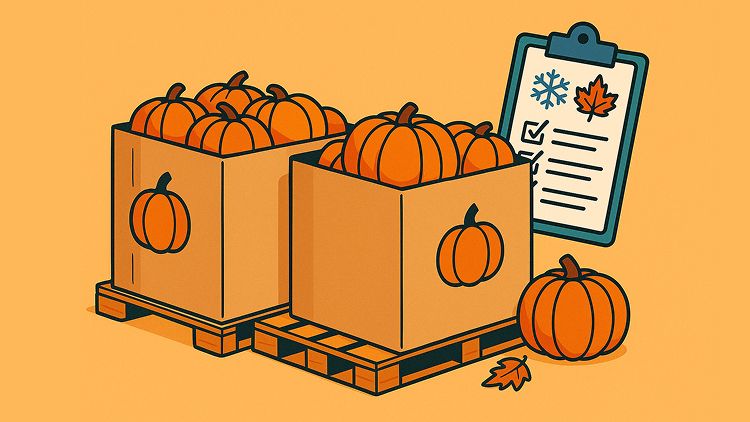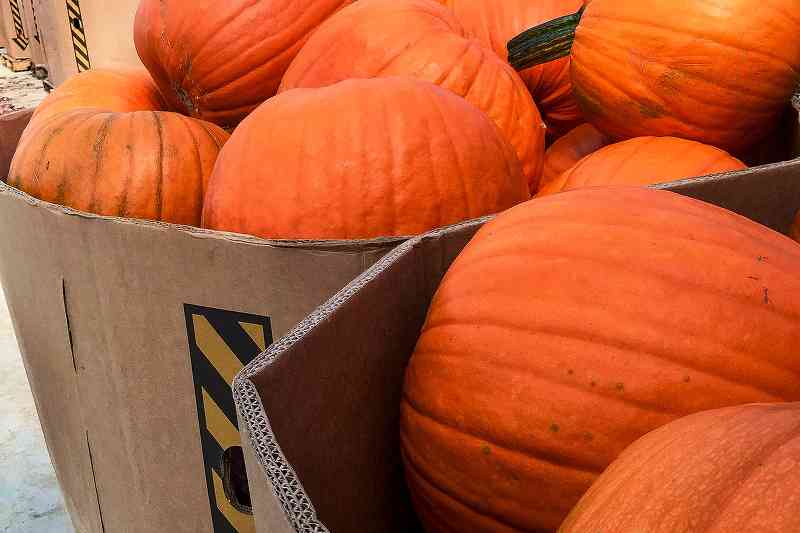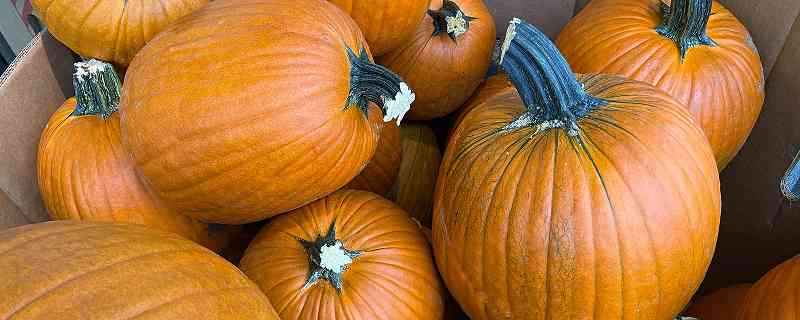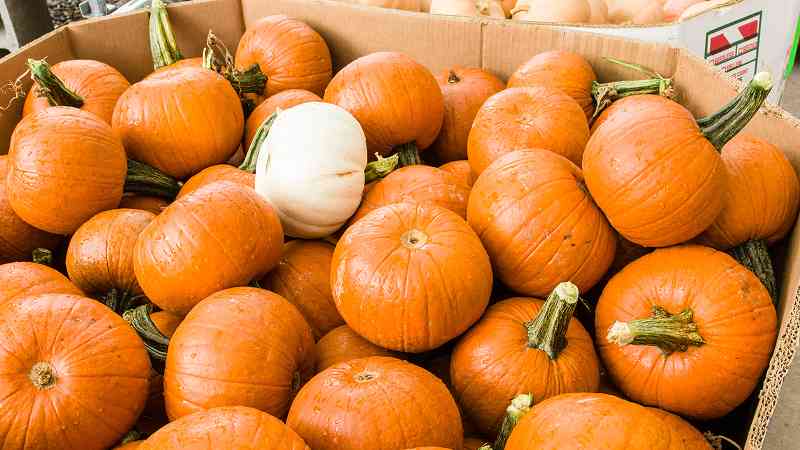Pumpkin Bins: 10 Tips for Late-Season Sourcing
How to find, vet, and move cardboard pumpkin bins between Halloween and Thanksgiving.

Key takeaways
- Move fast: late-season supply consolidates after Halloween—call reclaim channels first.
- Standard sizes (often 48" × 40") load and stack smoother; confirm internal dimensions.
- Write a simple QA: dry, no odor, intact corners; avoid moisture and delamination.
FAQs
What sizes of cardboard pumpkin bins are most common?
Pallet-friendly bases (often 48" × 40") with multiple height options. Choose lower heights for manual loading; taller for fewer containers and higher volume.
Are pumpkin cardboard bins suitable for cold storage?
Yes—if kept dry. Prevent condensation, use liners or pads, and avoid direct contact with very cold floors.
Where can I find bulk pumpkin bins after Halloween?
Check reclaim channels first—wholesalers, regional grocers, and distributors often consolidate bins in early November. Be ready for same-day pickup.
Are used pumpkin bins for sale safe to reuse?
If they’re dry, odor-free, and structurally sound. Inspect the bottom, seams, and corners. Avoid any with sign of moisture or chemical smell.
Do I need special liners for pumpkin bulk bins?
Not always. For late season, light poly liners with absorbent pads help control moisture. Confirm liner fit to the bin’s internal dimensions.
Why late-season pumpkin bins are different
Pumpkin Bins , a type of Gaylord produce box, can be plentiful before Halloween, then tighten quickly. After October 31, surplus consolidates at wholesalers while retail demand pivots to pies and baking. The window is short. Prioritize speed, clear specs, and flexible freight. For storage do’s and don’ts (temperature, humidity, and handling), lean on research-backed guides like UC Davis Postharvest (pumpkin & winter squash) and the USDA ARS Commercial Storage manual.

10 tips for late-season sourcing
1) Start with reclaim channels
Call produce wholesalers, DSD distributors, and regional grocers first. Ask if they’re consolidating bulk pumpkin bins and if you can pick up same-day. Offer to take a full lot to earn priority.
2) Ask for same-day pickup
Speed beats price in November. If you can pick up within 24 hours, say so up front—it often wins the bin.
3) Buy by the lot, not by the bin
Bundle multiple used pumpkin bins (plus freight) under one PO. Sellers want floors cleared; you get a better unit cost.
4) Prioritize pallet-friendly footprints
Common cardboard pumpkin bin sizes align with 48" × 40" pallets. They cube better in 53' trailers, slot into racks, and keep transfers smooth. If fit is tight, confirm internal dimensions—not just outside.
5) Set a quick QA screen
Keep it simple: dry, no odor, no bottom swell, intact corners. Reject moisture, bowing, or delamination on sight. A 30-second inspection saves hours later. For keeping product sound once bins are on site, see Purdue Extension’s pumpkin quality checklist (harvest-to-storage).
6) Line up backup sources
Have a short list ready: farm co-ops, produce auctions, recycling centers, and surplus packaging brokers. If the first channel is thin, you already know who to call next.
7) Hold a rolling PO
Offer a standing “not-to-exceed” price for wholesale pumpkin bins so suppliers can release inventory to you immediately without waiting for approvals.
8) Book flexible freight
Spot carriers that can move within 24–48 hours and allow multi-stop routings. November is about fast availability, not perfect routing.
9) Leverage the box graphics
Face the pumpkin illustrations outward. Cover Halloween-specific text with clean signage, and add “Pie Pumpkins” or “Baking” callouts to match pre-Thanksgiving demand.
10) Close the loop fast
On receipt, send photos and counts within 12 hours. Quick confirmation earns you first call on the next consolidated lot.
Pumpkin Bins: quick size and fit checks
Most corrugated bins for pumpkin storage you’ll see are pallet-friendly (often 48" × 40") with varying heights. Taller bins increase cubic feet; lower bins help with hand loading. If you mix lots, standardize on one or two heights to simplify stacking and displays.
Fast checklist:
- Verify internal dimensions for liners, slip sheets, or pads.
- Confirm safe unit height and aisle clearances.
- Label by height so staff don’t over-stack mixed bins.
If you need wet-service or produce-optimized corrugate (farm/retail environments, coolers, or heavy handling), see produce packaging programs from Georgia-Pacific and International Paper for what to expect from corrugated produce bins (triplewall, moisture-resistant options).
Choosing between new and used
- New / first-use: Most predictable condition and specs; higher cost.
- Used / surplus: Best value if dry, clean, and structurally sound. Inspect bottoms and corners first.
Keep shape and wall strength mentions brief. You don’t need exotic specs—sound corrugate, correct dimensions, and dry storage beat everything in late season.

Handling tips for displays and storage
- Vent & moisture control: If bins lack vents, crack the lid or use small side vents. Avoid condensation.
- Floor protection: Keep bins off cold concrete; use pallets and slip sheets to reduce bruising.
- Stacking: Cap stacks conservatively; colder weather can make corrugate brittle.
- Rotation: Use FIFO. Cull soft spots early to prevent spread.

A simple plan that works
Call reclaim channels first. Offer same-day pickup. Standardize on 48" × 40" footprints and one or two heights. Use a short QA checklist and flexible freight. Present bins cleanly with clear signage and pie-theme calls to action. You’ll keep displays full—and costs predictable—right up to Thanksgiving.
Looking for inventory right now? Explore our pumpkin bins for sale.
Sources
- UC Davis Postharvest Center — Pumpkin & Winter Squash Produce Facts: https://postharvest.ucdavis.edu/produce-facts-sheets/pumpkin-winter-squash
- USDA Agricultural Research Service — Commercial Storage of Fruits, Vegetables, and Florist & Nursery Stocks (Pumpkin): https://www.ars.usda.gov/ARSUserFiles/oc/np/CommercialStorage/CommercialStorage.pdf
- Purdue Extension / Indiana Vegetable Crops Hotline — Maximizing Pumpkin Quality: From Harvest to Storage: https://vegcropshotline.org/article/maximizing-pumpkin-quality-from-harvest-to-storage/
- Georgia-Pacific — Produce Packaging (corrugated produce bins): https://www.gppackaging.com/produce/
- International Paper — ClimaBin® Retail-Ready Bulk Produce Bins: https://www.internationalpaper.com/packaging/bulk/climabin

